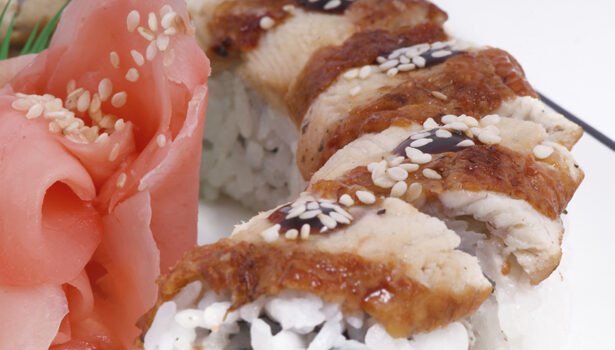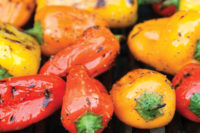Onaka suiteru? (Are You Hungry?)

©iStockphoto/sintaro

©iStockphoto/ Olga Koronevska


American chefs are reaching deep into the toolbox of Japanese cuisine, sifting through its culture, style, appreciation of nature, seasonality and uniqueness. They pull out interesting pieces and then meld them with their own culinary vision--to offer the American palate something new. How does this relate to prepared foods? The chef creations in fine dining trickle downward, until the flavors are widely found across supermarkets and fast food chains all over the country.
Styles and Types of Japanese Cuisine
Americans have yet to embrace all Japanese cuisine has to offer. Bring on the kaiseki, soba noodles, izakaya and, most importantly, the fresh, seasonal ingredients that are revered and prepared with care, in accordance with the utmost respect for tradition.
To say American palates are ready for Japanese cuisine is a big step, considering the fact that the traditions of Japanese cuisine date back to a time before America, as a country, even existed. The first Japanese restaurant opened in the U. S. in Los Angeles in 1855, in the neighborhood that would eventually become Little Tokyo. It was not until over 100 years later that the first sushi restaurant would open in America; in 1966, a little sushi bar popped up at a Japanese restaurant in Los Angeles. Similar restaurants soon followed in Chicago and New York. That may seem like a long time ago, but considering the fact that in 718 AD, the Japanese government allowed its citizens to pay their taxes with sushi, it seems to have taken a very long time for Japanese cuisine to get its foot in the door in the U.S.
Most American chefs of the last few decades have been using French techniques, but France is no longer the culinary power it once claimed to be, at least according to the Michelin guide and its revered stars. Japan leads the world in number of Michelin stars, and many are bestowed upon kaiseki-style restaurants, which serve traditional, Japanese multi-course dinners. These restaurants were much of the inspiration for American chefs serving prix fixe and multi-course dinners. As evidence of Japanese cuisine’s popularity stateside, the number of Japanese restaurants in the country doubled to nearly 10,000 in the 10-year period between 1996-2006. Also in that same time period, gastro pub-style establishments began popping up. These resemble a very popular concept in Japan called izakaya. From humble beginnings as simple watering holes, izakaya-style restaurants have turned into popular places to grab small bites and tasty beverages; they have exploded all over Japan and now spread their wings as far as U.S. shores. American dive bars, bowling alleys, diners and the like are turning out mouth-watering small plates and menu items from coast to coast.
Okonomiyaki, as hard as it may be to say, is something with which people may want to become familiar. It is a simple Japanese dish that has been compared to pizza by Japanese chefs--if only to give Americans a way to wrap their heads around the idea. Essentially, okonomiyaki is a pancake, roughly the size of an individual pizza, and the word translates to “what you like;” there are many different versions of the dish. Most okonomiyaki restaurants in Japan allow diners to grill the pancake themselves, and the dish becomes an amalgamation of any assortment of fresh or pickled vegetables, meats and Japanese noodles. Certainly, this is a dish and an interactive cooking style that will soon become popular in the States.
Chefs’ Interpretations and Inspirations
How do American chefs interpret the elements of Japanese cuisine to create something that American consumers are excited about? American chefs have done this successfully by pulling certain relevant elements from Japanese cuisine and incorporating these into their own style and vision--not by replicating traditional Japanese cuisine in a new land, but by reinterpreting it into something recognizable and approachable to U.S. palates. There seem to be a few chefs that have stood out in this field. Chef Masaharu Morimoto, of the Food Network’s famed Iron Chef, is one. Chef Morimoto has fused non-traditional ingredients, techniques and presentations with classic Japanese style. One dish that exemplifies this is “tunasciutto,” house-cured tuna, shaved thinly, topped with shavings of salted and dried tuna heart, chopped chives and white truffle--a new interpretation of the classic Italian beef carpaccio, but inspired by Japan.
Chef Tim Cushman, of O Ya restaurant in Boston, is another shining example. He preaches respect for flavors, while pushing the limits of unique combinations. O Ya is a Japanese expression of curiosity, and chef Cushman certainly puts together some curious concoctions that wow diners. At the Worlds of Flavor conference, held in November 2010, at the Culinary Institute of America, chef Cushman prepared a dish that represented his unique style. The dish utilized sushi rice in a non-traditional shape, topped with seared foie gras, served with balsamic chocolate kabayaki sauce, raisin-cocoa pulp and a sip of aged sake. On a menu, it may seem way “out there,” but the delicious aromas that wafted into the audience during the demonstration made audiences crave a chance to try it. Chef Cushman also offers up such eclectic dishes as shrimp tempura with bacon truffle emulsion and scallion ginger oil, or toro tataki with aji panca sauce and cilantro pesto.
New Takes on Traditions
Chef David Chang, of Momofuku Noodle Bar in New York City, takes a “no apologies” approach to his cooking. He creates dishes he feels inspired by--dishes that tend to be non-traditional and delicious. When chef Chang had difficulty sourcing high-quality katsuobushi (cured tuna), he created his own housemade version, using locally available ingredients--namely, pork. The process and technique is steeped in Japanese tradition--the pork is steamed, smoked, then dehydrated and buried in rice. The rice provides the bacteria used to create the unique flavor, a similar process found in making sake. This is yet another combination that marries Japanese techniques with American ingredients in an ingenious way.
Chef Tyson Cole is another star of this movement. His restaurants, Uchi and Uchiko in Austin, Texas, continue to win awards and woo customers with the innovative menu concepts. Uchiko has an eclectic menu with a fusion twist. King prawns served with basil seeds, smoked butter and a shrimp cracker are one example, and there is a Norwegian mackerel dish served with bluefoot mushrooms, onion, juniper and huckleberries that creates an amazing flavor combination. The sushi rolls also offer up some unique combinations; a Spanish twist is evident in the Toledo makimono roll built with big eye tuna, Spanish chorizo, fried almonds and grilled garlic. The key to the success of these unique combinations influenced by Japan does not lie in how bizarre or strange they appear, but in the balance of culinary principles and flavors, borrowed from each individual cuisine, to create a harmonious and tasty dish that can surprise and enlighten the taste buds.
This phenomenon is not only found in fine dining, but in smaller local joints all across the nation--certain evidence of the trickle-down effect from fine dining. Lomo Arigato is a food truck, based in Los Angeles, which brings together Japanese and Peruvian flavors, much to the delight of its loyal followers. Lomo saltado, its signature dish, is a unique item that combines one’s choice of protein, sautéed with onions, tomatoes, cilantro, soy sauce, red wine and, of course, French fries. All of this is served atop a bed of Peruvian rice. Dishes like this go to show that Americans are not only ready, but are already embracing change in the form of their favorite foods.
From izakaya to kaiseki, from Los Angeles to Boston, and from sushi to okonomiyaki, Japanese cuisine is certainly a vast empire that is quickly catching hold with American diners. One sees sushi in gas stations and on conveyor belts slithering through restaurants. Japanese eateries are appearing in Des Moines, Iowa, and Charleston, W.Va.--places one would not normally expect to find such cuisine.
American palates are yearning for what is next; something new to catch their eye and keep the taste buds guessing. Bring on the noodle bars and Japanese food trucks.pf
For more information about Japanese and Asian cuisines, type “Soy Sauce: Traditional and On-trend,” “Japanese cuisine” or “Asian cuisine” into the search field at www.PreparedFoods.com.
Looking for a reprint of this article?
From high-res PDFs to custom plaques, order your copy today!



